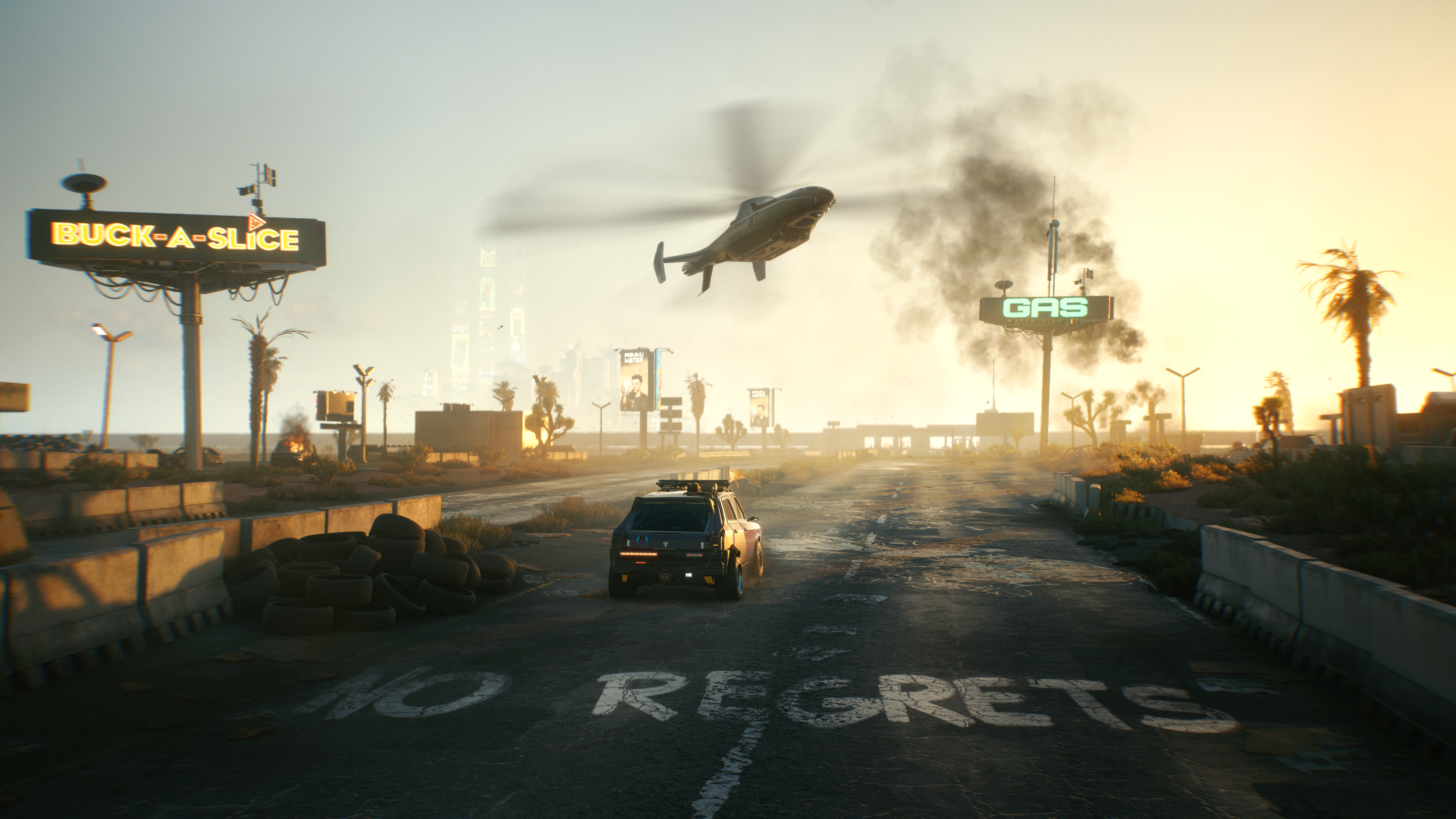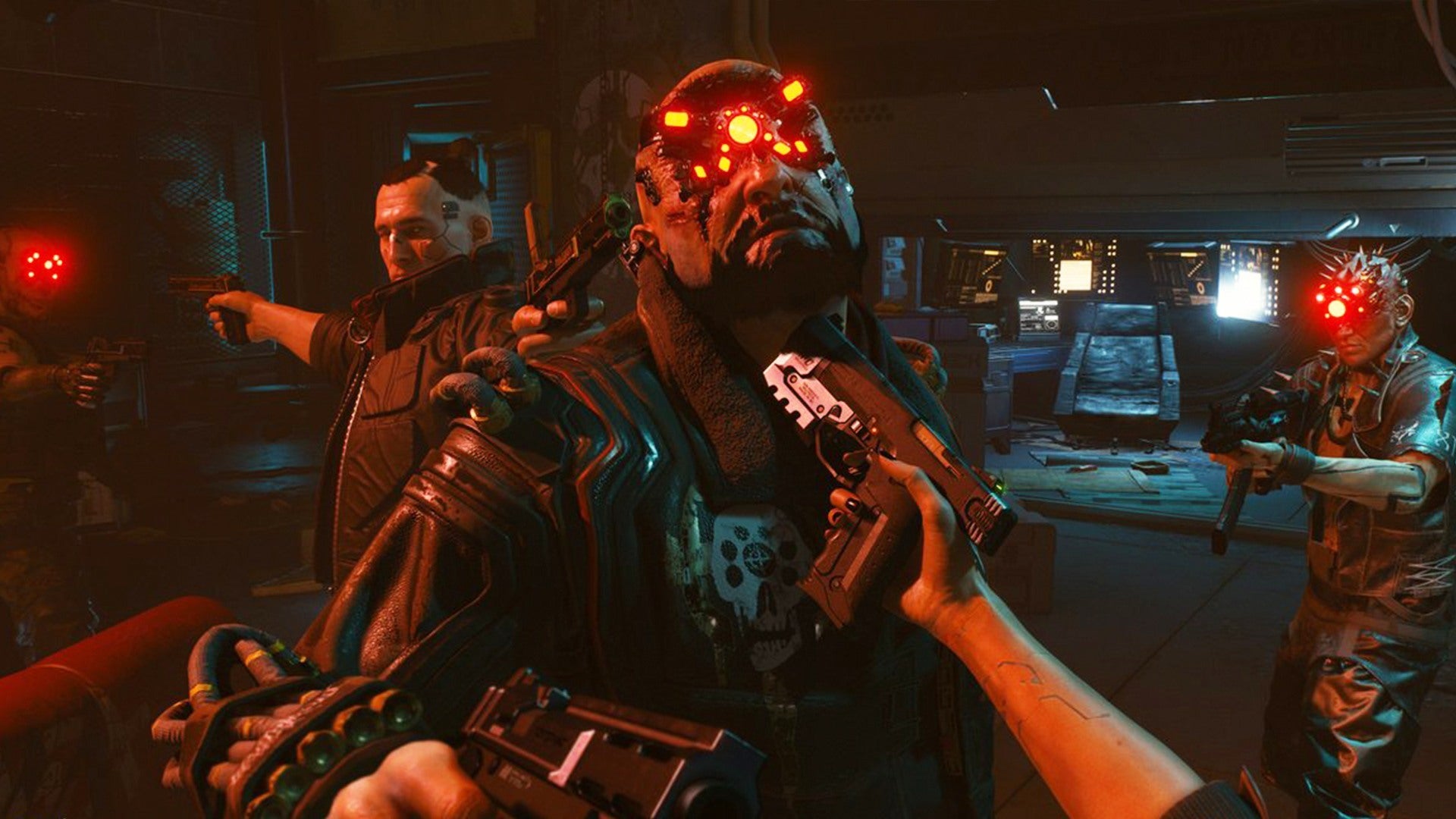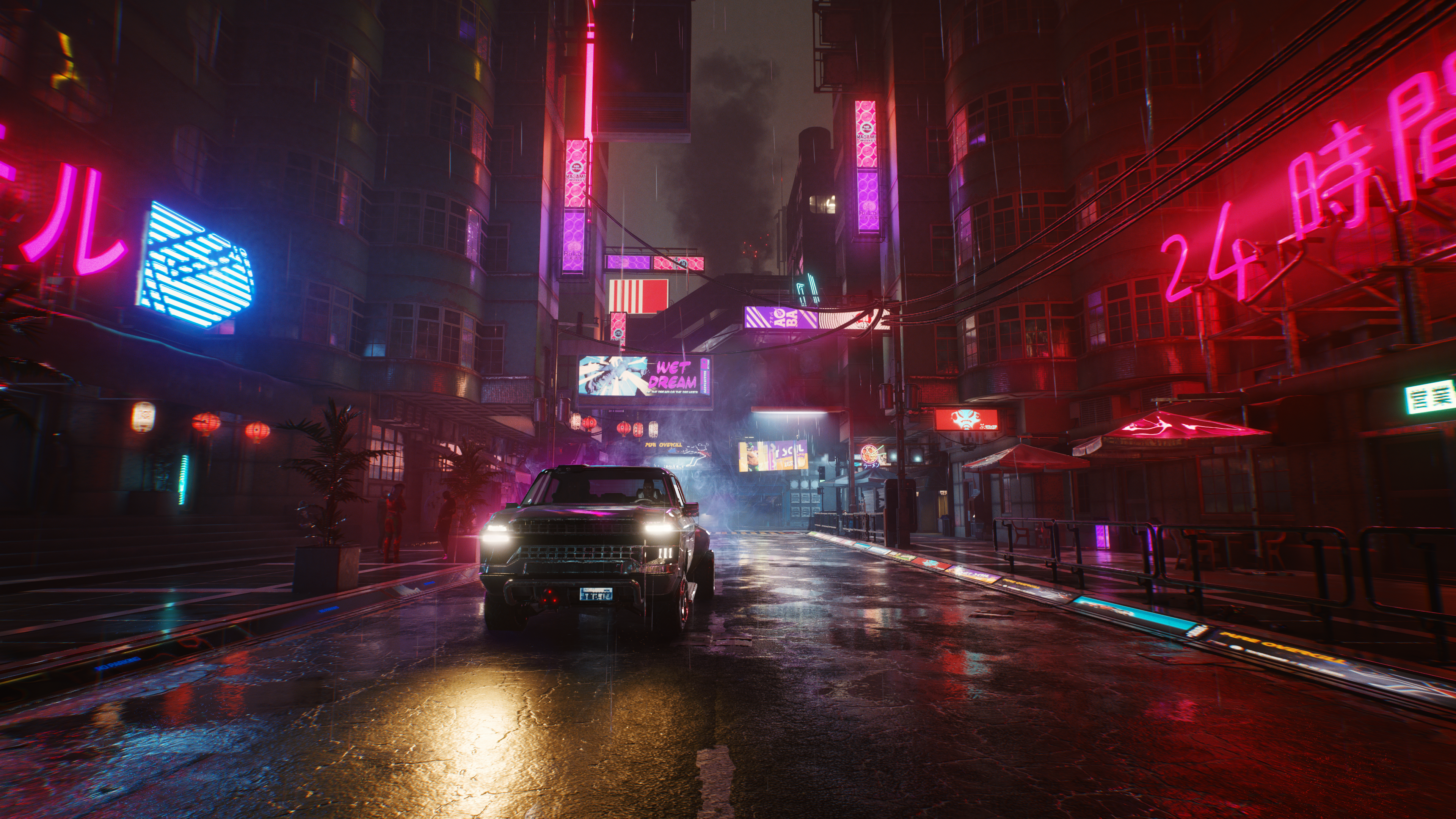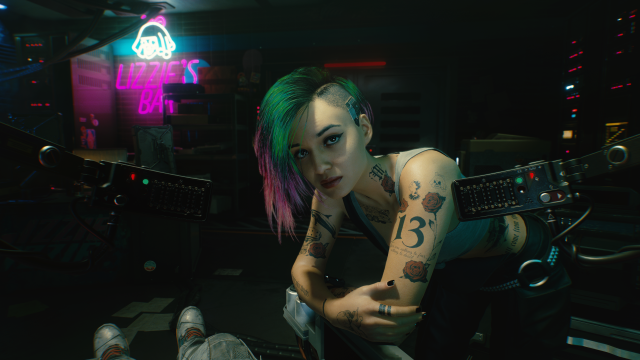Cyberpunk 2077 didn’t quite click with me until I met Certo.
In a recent demo with the Cyberpunk 2077 devs, I was guiding my character, an urban mercenary and hacker, through her neighbourhood when I was stopped by a local boxing coach near his outdoor gym. He had history with my character, apparently, and needed someone to test out the new practice robot he had purchased. My performance prompted the coach to explain that there were opportunities for competent street fighters to make some cash around the sprawling metropolis of Night City, where most of Cyberpunk is set. All I had to do was defeat other hopefuls in unsanctioned matches as a form of self-promotion.
Certo was waiting for me on a rooftop in the borough of Kabuki. At first, it wasn’t clear who was my opponent; two identical fighters were shadowboxing when I arrived, and both were itching for a fight. It turned out that they were Certo: One consciousness, two bodies. Certo explained that they had once been twins who were so closely bonded that they installed “neural oscillation synchs” to become an entirely new person. Naturally, I negotiated an increased payout, since I would technically be fighting two opponents, and then set about beating down this perfect encapsulation of the game’s aesthetic.
Cyberpunk, like most wide-reaching genre descriptors, is hard to explain and even more difficult to nail down as a creator. Everyone has their own understanding of the term depending on the cyberpunk entertainment they’ve interacted with. At first, Cyberpunk 2077 didn’t feel “cyberpunk” to me. Sure, developer CD Projekt Red nailed the grimy future that often accompanies the setting, but it felt artificial. My short interaction with Certo, however, is what finally won me over to the developers’ vision. The multi-bodied fighter revealed the human heart beneath the game’s chrome sheen, and that encounter in particular stuck with me even as a deluge of gameplay mechanics took centre stage.
Cyberpunk 2077 is the next sprawling adventure from the developers of The Witcher. Much like the tabletop roleplaying game it adapts and the genre of science fiction for which it’s named, Cyberpunk 2077 depicts a world that, while technologically advanced, has yet to solve the greed that serves as the foundation for many of society’s ills. Megacorporations have replaced nations as the world’s dominant superpowers. Necessities like food and health care are reserved for those wealthy enough to afford them. The next stage of human evolution has been artificially jumpstarted by the rise of cybernetic implants.
Even the way I played Cyberpunk 2077 felt strangely futuristic. While CD Projekt Red would have normally shown off the game at E3 around this time, the ongoing covid-19 pandemic forced the developers to figure out an alternative for the typical in-person demo. That’s how I wound up streaming Cyberpunk 2077 from my home office yesterday, playing one of the most anticipated video games of the year at my desk in my sweats and a ratty tee shirt. Along for the ride was quest director Mateusz Tomaszkiewicz, who patiently guided me and answered whatever random questions I had during my trip through Night City.
Cyberpunk 2077 tells the story of V, a mercenary whose appearance and background are decided by the player at the beginning of the game. I was given the choice between two body types — one that would traditionally be considered masculine and the other feminine — and then asked to choose my vocal tone, which would in turn decide the pronouns NPCs would use when referring to me. Again, there were just two choices that adhered to the limited male/female dichotomy. While this meant that V’s body doesn’t lock them into a gender, there’s currently no way to, say, make a character with traditionally feminine features that uses masculine pronouns or vice versa. My version of V had a face scarred with permanent body modifications and a bright green shock of hair.
Apart from aesthetics, a major aspect of character creation concerns V’s origins. Cyberpunk 2077 offers the player three distinct backgrounds: the Street Kid from the school of hard knocks, the lone wolf Nomad from the outskirts of Night City, and a privileged Corpo officer at Arasaka, one of the most successful and powerful megacorporations in the game’s world. Cyberpunk 2077 doesn’t change dramatically depending on which background you choose — the biggest difference is probably the unique prologues that open the game — but Tomaszkiewicz said that V’s origins will affect the way they’re treated by certain NPCs and some of the dialogue choices presented to the player.

My version of V was a Nomad, a social class that exists outside of Night City and travels in tight-knit, familial groups. Her story opened in a dusty garage in a settlement outside of Night City after having left her clan. A local mechanic was struggling to fix her car’s electric coupling module, and intimated that most people would be wary about a lone Nomad drifting this close to the city limits. I had V shove him aside and fix the problem herself when it didn’t seem like he could get the job done. Eventually, the local sheriff showed up, giving me the opportunity to engage in some shit talking before heading out on the open road for my first mission: smuggling an extinct iguana stolen from some corpo jerk.
That adventure didn’t go well — I was ambushed by corporate agents after bribing my way through a checkpoint, leading to an intense car chase sequence — but it did introduce me to Jackie Welles, who remained my closest ally during my time with the game. After a brief timeskip, I reached Cyberpunk 2077 proper and was let loose in the game’s open world, free to explore to my heart’s content.
Cyberpunk 2077 is a first-person roleplaying game that’s a little bit Deus Ex and a little bit System Shock, with the conversation systems of Fallout and the open-world randomness of Grand Theft Auto thrown in for good measure. V’s abilities are determined by a set of five stats — Body, Intelligence, Reflexes, Tech, and Cool — each of which have multiple perk trees. Reflexes, for instance, governs V’s critical hit chance and evasiveness, while a high Cool score will improve their aptitude for stealth. A separate stat, Street Cred, indicates V’s status in the Night City underworld, combining with your overall character level to unlock more missions and allow use of better equipment. Augments alter V’s body in unnatural ways, adding things like eyes that improve their aim and arms that can transform into rocket launchers.
Since there are no classes in Cyberpunk 2077, you’re allowed the freedom to build V any way you want. Naturally, this also extends to the game’s missions, which can be completed with a variety of tactics. Early on, V is tasked with retrieving a military-grade spider-bot from the Maelstrom gang, a group of criminals who practice extreme forms of body modification. Many no longer have true eyes, opting instead for mechanical implants that turn their faces into horrific, concave testaments to their obsessions with technology. During negotiations, you encounter Maelstrom leader Royce. You can opt to simply shoot him in the face rather than suffering through his demands after the conversation grows heated. This sets off a desperate, violent escape from the Maelstrom base but also skips a tough boss fight against Royce near the end of the mission, according to Tomaszkiewicz.

Cyberpunk 2077 combat is composed of four distinct elements: guns, melee, stealth, and hacking. Each one will generally be useful for every mission, but it’s up to you how to use them in tandem. V can take cover behind stationary objects, during which aiming down the sights of your weapon can be used to make her pop in and out of safety. The melee system includes light attacks, heavy attacks, blocking, counters, and dodging, all of which require careful management of a stamina metre. I often found myself accidentally draining V’s energy during fistfights, with no way to regain stamina other than to let my opponent pummel me. But, like most things in the game, I’m sure this can be improved by investing in the proper skills, perks, and equipment.
I’ve always found stealth rather awkward in first-person games, and Cyberpunk 2077 struggles with it as well. I never knew if I was hiding properly thanks to the limits of my perspective, which led to several instances of alerting off-screen enemy guards despite thinking I was safe behind a box or automobile. Hacking was similarly frustrating. By holding a button, your view shifts into one that shows which nearby objects can be hacked. That said, I never really got a good sense of what I could hack and where in the game’s cluttered environments. It’s clear that Cyberpunk 2077 expects you to constantly shift into the hacking mode, but it’s often difficult to pull off during heated firefights. The benefits, however, were obvious. Distracting enemies with hacked monitors, drawing them to certain locations, and then using hacking to remote detonate their grenades proved to be a potent combination in an in-game VR tutorial given to me by one of my allies after completing the prologue, but similar opportunities never seemed to materialise during my short time in Night City.
My next major mission in Cyberpunk 2077 involved acquiring an Arasaka prototype known only as “the Relic.” Yorinobu Arasaka, heir to the megacorp that bears his name, previously stole the object from the company’s labs for unknown reasons, and it’s up to V and her crew to lift it themselves for their client. Although the demo ended right as V was heading to Yorinobu’s penthouse, the multi-stage planning of the heist showed just how compelling the game can be without asking you to pull a single trigger.
Preparing for the mission involved using a braindance. Braindances are like virtual reality on speed in the world of Cyberpunk 2077. They’re essentially recorded memories that can transfer every emotion and sensation to a viewer when played back. This has obvious erotic uses, but some folks pay top dollar for braindances in which the person recording feels heightened levels of anxiety and fear or even dies. In the training example that served as the feature’s tutorial, a street tough robs a convenience store and then gets shot in the head, leaving V a shivering mess upon her return to the real world.

The true usefulness of braindances, however, is found in their editing mode. While editing a braindance, V can move freely around the memory, seeing and hearing everything the person who made the recording saw and heard. This can often turn up hidden details, like who shot the street tough in the example above. Focusing on the security monitor behind the register reveals that the thief’s partner in crime was the one who murdered him, all in an attempt to make the braindance more valuable on the black market.
You put this knowledge to good use while scouring a braindance recorded in Yorinobu’s suite. By listening to a phone conversation and investigating Arasaka’s communication devices, you can learn that the relic needs to be stored somewhere cold. This sets off a scavenger hunt in which you need to scrub the braindance with a thermal filter to figure out where the relic is hidden in the penthouse. My first two experiences with braindance editing weren’t all that complicated, but the possibilities are exciting. I would honestly play a full game that focused entirely on this kind of futuristic investigation, and it’s only one small part of the full Cyberpunk 2077 adventure.
There’s a lot going on in Cyberpunk 2077. Night City hums with a dizzying mixture of organic life and unrestrained corporatism, a macrocosm of each resident that slices into their body to install better eyes, stronger legs, more resilient muscles. The game is full of random events — wild car chases, hostage situations, and explosive gang wars appear constantly while you drive through the massive metropolis — and intricate systems like the various perk trees and hacking minigames, both of which ask you to fully immerse yourself in a way few games do these days. During my four hours with the demo, it became more than a little overwhelming to try to keep track of everything. But nothing feels superfluous or artificial. Every event and gameplay feature felt like it had a purpose in the larger picture, even if I couldn’t get my head around it. Overall, Cyberpunk 2077 is a roleplaying game in almost every sense of the word, giving you just enough room to craft your own experience without going overboard.

Near the end of my preview, Tomaszkiewicz asked me to open the in-game map and suggested I check out a specific waypoint. When I got to the mission marker, I found an alley surrounded by police barricades. Screaming people ran as fast as they could from the area. It didn’t take me long to find out why. A woman was in the midst of cyberpsychosis, a futuristic mental illness brought about by the overuse of artificial augmentations that causes victims to react violently to fellow human beings. She seemed to teleport around the empty lot, making use of a stealth implant to warp in and out of sight before attacking me.
I was flustered and quickly assumed that I had no other choice but to kill her, but it didn’t sit well with me. Tomaszkiewicz explained that cyberpsychosis is common in the world of Cyberpunk 2077, and said that the game even includes a series of side missions that revolve around investigating the affliction’s prevalence in Night City. The authorities, he said, are quick to diagnose someone with cyberpsychosis no matter how subtle their symptoms, often resulting in false positives. I asked if I could have saved the sick woman instead of killing her, and Tomaszkiewicz said that, yes, you can save people with cyberpsychosis if you manage to subdue them with non-lethal weapons or stealth tactics.
Even after four hours, I still don’t feel as if I got a good handle on everything Night City has to offer. But I can’t wait to play Cyberpunk 2077 again, if for no other reason than getting a second chance at saving that woman and getting her the help she needs.

Leave a Reply